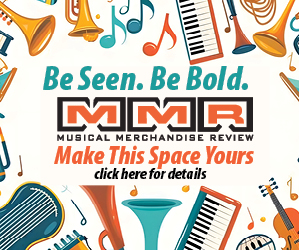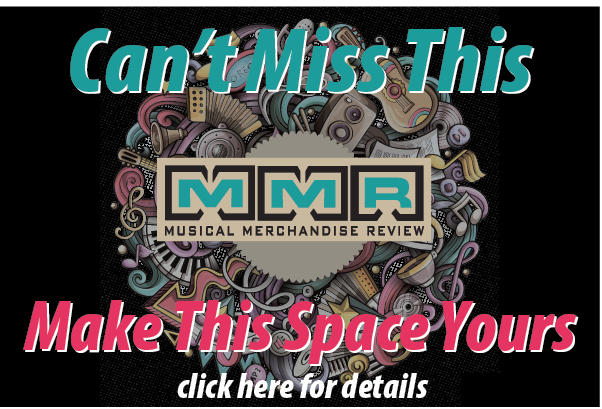 If a salesperson approached you at NAMM and told you that you could increase your sales by 20 percent, you’d probably say thanks but no thanks – there’s no way that’s possible. But when Sean Roylance of Rain Retail Software says that’s what his company does, it’s not some scheme, it’s the verifiable data from customers who’ve employed his software in their stores.
If a salesperson approached you at NAMM and told you that you could increase your sales by 20 percent, you’d probably say thanks but no thanks – there’s no way that’s possible. But when Sean Roylance of Rain Retail Software says that’s what his company does, it’s not some scheme, it’s the verifiable data from customers who’ve employed his software in their stores.
Rain Retail is a software company that streamlines inventory information, a store’s website, and their POS into one cloud-based seamless system. Put simply, the software allows independent brick and mortar stores to have the same online capabilities as big box stores. With Rain Retail Software, stores access their point of sale and inventory management all combined with their e-commerce website, boosting the accuracy of their inventory for both employees and customers.
As Roylance explains, “If you sell [a particular item] in the store, it comes down off the website. If you change the price, it’s reflected immediately on the website. Everything is always showing accurate and up-to-date at all times because it all operates from one single back-end cloud-based database.”
Roylance has seen overwhelming success with businesses – both in MI and other stores – who have taken the software on.
“We wanted to know, during the first 12 months with us, what happened to their gross revenues?” he says. “And on average, their gross revenues increased by 21.5 percent. So, if you are a store doing $500,000 a year, now you just grew by 21.5 percent, now you’re up over $600,000 a year. For them, that’s a massive difference.”
That very “massive difference” has been years in the making. Growing up on a farm in central Washington in the ‘80s, Roylance first got a computer at age 12: A Commodore VIC-20 with 4k of memory. With the computer, he started programming, making him one of the only kids in his high school who knew how when he was older.
“In hindsight, it was great growing up on a farm, I learned how to work a lot. But my whole goal in life was get off the farm,” he says. “I have fond memories now. At the time, it was a lot of hard work. It was cold, working with cattle in the snow, doing hay in the summer, all that kind of stuff. Then I went off to college and studied computer science, because I really liked that programming element. About the time I was wrapping up school is when I realized that entrepreneurship was something that I was interested in. But as a programmer, at that point, I got a full-time job programming before I finished school.”
Roylance worked as a programmer for over 10 years, but the major career shift came from Roylance in 2008 when he attended a trade show with his wife, a quilt pattern designer, to sell her patterns. In hindsight, Roylance says, the afternoon wasn’t especially lucrative, but it pivoted him in the right direction to start Rain Retail Software.
“When I was there, somebody came up and said, ‘Hey, we do e-commerce websites for people in this industry.’ I looked at what they had and felt like it was very lacking. I thought that I could build something that could do better. And so, for the next six months, I went back home and spent all my evenings, weekends, holidays, vacation days just coding all the time and built our very first version of our e-commerce platform that still carries on to this day.”
At the next trade show, Roylance signed up his first 24 clients with his new software in-hand. Following the new sign-ups, he quit his full-time job in 2009 and officially started Rain Retail Software, aiming his business towards specialty retail stores. While his initial venture was with craft stores, he quickly learned that the same software helped music and sporting goods businesses.
“At this point, that today is kind of our bread and butter is specialty retail,” he explains. Around 2012, Roylance and his team noticed that customers were often researching items online for price and product specs, then going into stores to test out the item and purchase it. Pouncing on this new retail behavior, Rain Retail Software established a cloud-based system, which combined point of sale inventory management with a store’s e-commerce website.
“In 2012, we began to really see this behavior evolving quickly amongst consumers, and we saw these stores that were having some real significant success,” Roylance says. “As we worked with retail stores and we helped them get all their products onto their website with their current inventory counts and the current prices, [we saw] that when they did that and kept it up to date, it was having a big impact on their overall sales. We found what would happen is that their revenues would grow very noticeably, but most of that growth actually occurred via in-store sales. That the way it would work is people would go online, see, ‘Okay, they have this guitar I’m looking for. I’m going to go into the store and check it out.’ And then they end up making the purchase once they get into the store. But the reason why they went online was to do some pre-work, if you will, and look at things before they then made that trip.”
In many cases, the cloud-based system has allowed customers to find out about products that are in storage but haven’t even been displayed yet, all thanks to them finding items listed online. These kinds of scenarios are exactly what contribute to the significant aforementioned sales boost.
The installation process is piecemeal, allowing stores to take small, manageable steps to get their inventory logged and e-commerce site established without having to close the store for days at a time. On average, Roylance says the process takes six to eight weeks in a series of trainings, but once everything is in place, the payoff begins.
Many stores have even reported back to Roylance and his employees that new hires pick up their software far faster than their older systems. And if problems do arise, he and his team offer unlimited customer support. In total, Rain Retain Software employees roughly 85 people across their departments, which span onboarding specialists and general support employees who can provide training and additional insight.
“We very much hold their hands,” Roylance notes. “That’s one thing that sets us apart from a lot of the modern software systems and businesses out there. We feel you need that modern, easy-to-use technology, but as you tackle these different business needs, it does introduce complexity, and so you need that support as well.”
Regarding pricing, each business pays one flat initial setup price, and additional monthly payments that vary based on each business’ number of checkout lanes and locations. The monthly fee includes the store’s website, hosting, software upgrades, and customer support.
Music-Minded Software
While Rain Retail was originally founded on a basis of craft supply stores, Roylance has found that his software lends itself especially well to the intricacies of running independent MI stores. Aside from easily categorizing and tracking serialized inventory and repairs, the software easily plugs a store’s inventory into Reverb.com so that they can seamlessly sell products there as well.
“We’ve seen some stores just do some tremendous volume of business on Reverb,” Roylance explains. “Again, the amount of work that it takes to do that is just next to nothing, because everything is all on our system. They get it [a product] in, they put it into their system, now it’s up on their website, it’s also on Reverb. If it sells on Reverb, we immediately take it down automatically off the website, and they know about it. If it sells on the website or in the store, we immediately take it down from Reverb. That’s been a really powerful thing for these retailers to now be getting their products out in another area where people can go and see what they have for sale and do business with them.”
In addition, the Rain Retail software also simplifies many other MI-related aspects of a business, like handling instrument rental and rent-to-own programs. This includes providing an easy way to intake customer and payment information.
“As far as we had encountered to this point, the concept of rent-to-own is unique to the music industry,” Roylance says. “We just recently finished our initial substantial offering for rent-to-own. The thing that’s really great about it is that people can go online and sign up to do a rent-to-own. Then they can also go online to update and make payments. But then, maybe the credit card that they have on file is expired, or for whatever reason doesn’t work. Well, we have automated themes, like, where you can send out a text message to the clients saying, ‘Hey, your payment failed. Click here, go to the website, enter in a new credit card and update your payment information.’ All that without the store having to even know that the payment was declined.”
Another notable music-specific feature of the software is that Roylance and his employees have worked with major manufacturers and distributors in the music industry to collect useful product info. By gleaning product photos and information directly from the manufacturers, store owners don’t have to manually enter product specs for every item in their inventory. Instead, those details auto-populate by merely scanning the item’s barcode or typing its name.
“After discussion, what we found over and over again with store owners is one of the things that they value most would be that ability to get some of their time back,” Roylance explains. “That’s really what we’re shooting for with many of these tools and integrations.”
In addition, MI stores can easily take in and manage consignment items. In an effort to automate the consignment process, customers who’ve dropped off consignment items can see their status – sold or unsold – and receive an automatic message and payment when an item does sell.
Future Integrations
Looking ahead, Roylance plans to add even more features to his software. In progress are ways to directly integrate selling items with Amazon and eBay, much like Rain Retail Software already does with Reverb. This feature would remove “a third-party layer” that Roylance says often reduces the quality of the integration. While he has found that Reverb is still number one in online instrument sales, he explains that Amazon and eBay also move a significant amount of MI gear.
“Reverb is doing more instrument sales than Amazon and eBay combined. I’m not trying to be a salesman for them [Reverb],” he says. “Nevertheless, there’s still quite a bit that happens on Amazon and quite a bit that happens on eBay. We want to get retailers plugged into those channels as well.”
Add these new integrations to Roylance’s already-successful and efficiency-boosting software, and the profits are noticeable. “When that store signs up with us, there is that legitimate 20 percent bump in sales increase on average, plus a potential another 20 percent increase in sales through Reverb. If you can make one key decision and get a 20 percent to 40 percent increase in sales, to us, it’s a no-brainer.”
Since the onset of the COVID-19 pandemic, Rain Retail has created a microsite that’s designed to share insight, resources, and news on new features, with the main focus of helping clients weather the COVID-19 crisis. Check it out here: wwww.rainpos.com/insights-and-resources




























